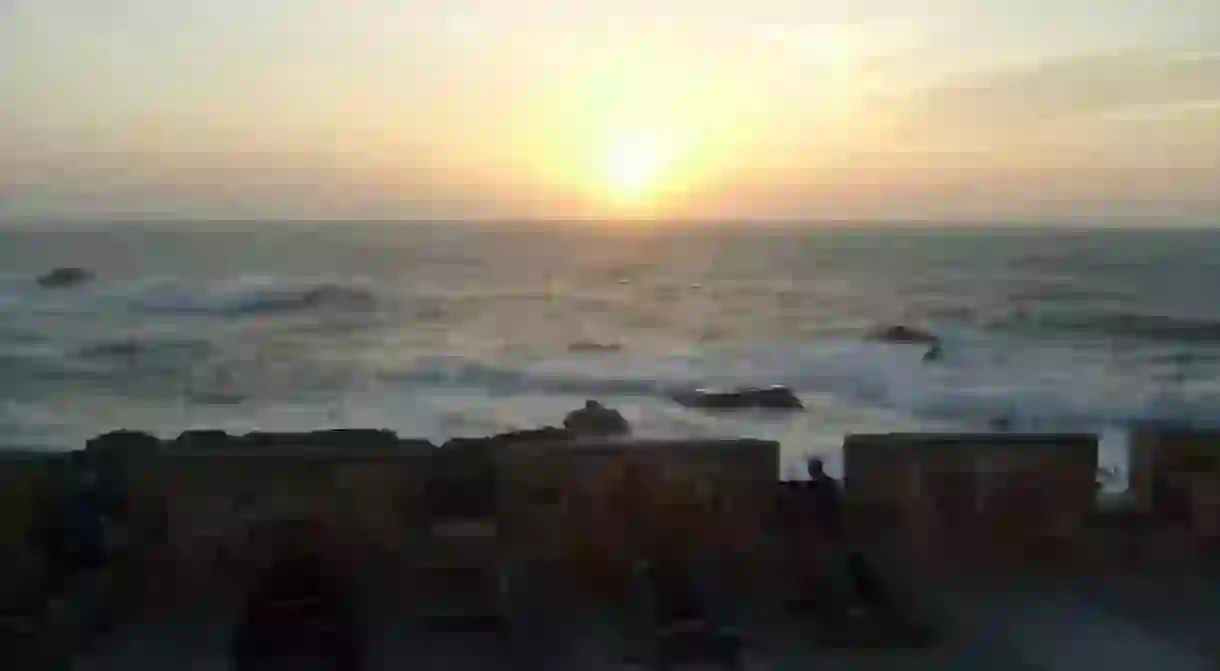Expelled from Paradise: The Fishermen of Essaouira

Essaouira in Morocco is a town with two distinct personalities. While on the surface it’s a laid-back, fresh fish-filled haven that sways with history and culture, it nonetheless possesses a great sadness.

Essaouira was built as a coastal fortress in the 16th century by the Portuguese who held it for many years, despite the attempts of many other European nations to occupy it, until Morocco took it back as a main trading port for Marrakech. Its high walls and ramparts still protect the shoreline today; the cannons pointed at the Atlantic are constantly straddled by tourists looking for a photo opportunity. However, Essaouira is not a place of historical pilgrimage for visitors, but more a painful reminder of progression and waning heritage for local fishermen.
The blue and white town looks like a mini-utopia in contrast to the dirt and dust in Marrakech. There are traces of the usual trappings indicative of Morocco, but the bullish heckling from tradesman, usually associated with the inland cities, is nowhere to be found. And there is still a romanticism that hangs in the air, which is only associated with seaports, unlike Casablanca on the northern coastline, now a malodorous city of industry with no sight of the romance of Humphrey Bogart and Ingrid Bergman.

Essaouira, though, is a cultural hub embracing the full gamut of the arts. Furnished with contemporary galleries, music shops and poetry readings, it is probably most famous for hosting the ‘Gnaoua World Music Festival’, which attracts people from around the globe. It is a place of inspiration, too: it is believed that Jimi Hendrix wrote ‘Castles Made of Sand’ here; also, Orson Welles chose to film an adaptation of Othello in parts of the town, hence the presence of Orson Welles Square, complete with a concrete bust of the late actor-director, just outside the centre.
This, perhaps, explains the colourful array of visitors taking in the sights; you can hear the scrape of sandals as a haze of hippies stroll around the main square, families from other parts of Morocco and beyond treat themselves to a seaside break (I was delighted to listen to a father and his two children play Irish jigs on violins by the harbour) and surfers and paragliders lounge on the beach. And it’s the weather which attracts the latter of these tourists. Extreme sports enthusiasts enjoy biblical winds and waves that send them skimming across the surface of the sea and send their stunt kites skyward. A blast from the coastal breeze, similar to the mistral in Southern France, also alleviates the stress and roasting suffered in the more metropolitan areas of Morocco where the temperatures can reach unbearable levels.
Those with a culinary agenda will find unrivalled seafood cooked along a row of open-air fish grills set back from the esplanade. Before taking a seat in the canvas-covered dining area the waiters will ask you to choose from their menu laid out in baskets of ice. There is an endless selection, including fresh sea bass, sardines, shrimp, swordfish, mackerel: the platters are like aquariums of food. Everything is cooked on the same griddle, remarkably simple yet unforgettable.
Yet if you crack the veneer of the town, you will discover that Essaouira holds a murky secret. As a result of depleted resources in the fishing industry the town’s main reason for trading has suffered severely, causing considerable unemployment for the fishermen in the area. Many have failed to find work and now they gather on the seafront to sit around a bonfire, idle.

After declining a ‘cosmic’ macaroon from a local baker, opting for the chocolate flavour instead, we began to discuss the ragged crew milling around the seafront. The baker told me there are two worlds in Essaouira: the very clean and idyllic tourist town, and the rising unemployment and drug abuse amongst the marginalised members of society. He went on to explain that most of the jobless fishermen turn to heroin often traded or used in the coves in front of the old fortress walls. This seems to be common knowledge, as most of the natives watch these poor souls traipse across the sand to rock pools to forget themselves and the thriving tourism around them. The owner of an orange juice stand on the esplanade described to me how he sees more of these unemployed fishermen congregating in front of his stall every year, how he felt sorry for them for not having a purpose anymore. But the general feeling is detachment; they distance themselves from the straight-laced locals and the locals are happy to reciprocate that distance.
Sunset draws the day to a close and the chefs from the esplanade grills toss fish guts onto the paving stones for the seagulls. Tourists fill the restaurants and cafes after eyeing up tie-dye T-shirts and tagines, oblivious to the guttering bonfire and quiet desolation huddled up in the coves. For the week I spent in Essaouira, my evenings did consist of eating out and the like, but most evenings I would sit and observe the ghosts of fishermen haunting the shoreline. It is important for towns to evolve with the planet and make use of existing attributes. Still, I couldn’t help but feel I was witnessing a generational stupor, flickering and fading on the rocks.













